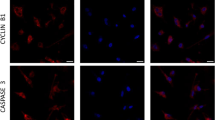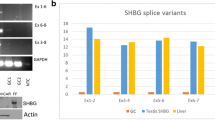Summary
In order to obtain an exact definition of the luteinizing process in Granulosa cells, Granulosa cells from 13 preovulation follicles, as well as 4 corpora lutea from human ovaries were examined electronoptic-morphometrically. The definition of the preovulation ruptureready follicles wasn't obtained alone through the data about the near ovulation time of the cycle, but through the measurement of the LH-concentration in the serum in the periovulation stage. Out of the 13 women examined, no follicle rupture took place up to the 15th day of the cycle.
By comparing the electronoptic-morphometric data of the Granulosa cells of the individual follicles with the concentrationcurve of the LH in the periovulation stage, it was possible to divide the 13 follicles into 2 groups, which could be compared with a third group consisting of the corpora lutea.
Our examination of Granulosa cells of follicles with increasing LH-concentration and a LH-maximum in serum produced characteristic changes of the fine structure, which let one conclude a transformation of a proteinsynthetic to steroid-biosynthetic active Granulosa cell. This transformation process is defined as „luteinizing process“. It comprises morphometrically in addition to a great increase in volume of the nucleus and cytoplasm, a clear increase and dominance of the smooth endoplasmatic reticulum over the rough type, a momentary increase of lipid drops, an increase in size of the Golgi bodies as well as a great increase of the mitochondria.
Zusammenfassung
Zur genaueren morphologischen Definition des Luteinisierungsvorganges der Granulosa wurden 13 präovulatorische Follikel sowie 4 Corpora lutea menschlicher Ovarien elektronenoptisch-morphometrisch untersucht. Die Definition der präovulatorischen sprungbereiten Follikel erfolgte nicht allein durch die Angabe über den ovulationsnahen Zyklustag, sondern durch die Messung der LH-Konzentration im Serum in der Periovulationsphase. Von den 13 untersuchten Frauen war bis zum 15. Zyklustag ein Follikelsprung nicht erfolgt.
Bei der Gegenüberstellung der elektronenoptisch-morphometrischen Daten der Granulosazellen einzelner Follikel zum Konzentrationsverlauf des LH in der Periovulationsphase war eine Gruppierung der 13 Follikel in zwei Gruppen möglich, die mit jungen Corpora lutea einer dritten Gruppe verglichen wurden.
Unsere Untersuchungen an Granulosazellen von Follikeln bei steigender LH-Konzentration und einem LH-Maximum im Serum ergaben charakteristische Veränderungen der Feinstruktur, die auf eine Transformation einer proteinsynthetisch zur steroidbiosynthetisch aktiven Granulosazelle schließen lassen. Dieser Transformationsprozeß wird als „Luteinisierungsvorgang“ definiert. Er umfaßt morphometrisch neben einer starken Volumenzunahme von Kern und Zytoplasma eine deutliche Zunahme und ein Überwiegen des glatten endoplasmatischen Retikulums über die rauhe Form, eine vorübergehende Zunahme von Lipidtropfen, eine Vergrößerung des Golgiapparates sowie eine starke Zunahme der Mitochondrien.
Similar content being viewed by others
Literatur
Beltermann, R., Stegner, H. E., Breckwoldt, E.: Electron microscopic observations in mice ovaries after administration of human hypophyseal gonadotropine (HHG). Acta Endocrinol. (Kbh.)100 (Suppl.), 75 (1965)
Beltermann, R., Stegner, H. E.: Elektronenmikroskopische Untersuchungen an den Ovarien neugeborener Mäuse nach Behandlung mit humanen hypophysären Gonadotropine (HHG). Acta Endocrinol. (Kbh.)57, 279–288 (1968)
Bjersing, O.: On the morphology, endocrine function of granulosa cells in ovarian follicles and corpora lutea. Acta Endocrinol. (Kbh.)125 (Suppl.), 4–23 (1967)
Bjersing, L. S. Cajander: Ovulation and the mechanism of follicle rupture. Cell. Tiss. Res.149, 287–300 (1974)
Blanchette, E. J.: Ovarian steroid cells. I. Differentiation of the lutein cell from the granulosa follicle cell during the preovulatory stage and under the influence of exogenous gonadotropins. J. Cell. Biol.31, 501–542 (1966)
Channing, C. P.: The use of tissue culture of granulosa cells as a method of studying the mechanism of luteinization. In: The gonads (ed. K. W. McKerns), pp. 245–275. Amsterdam: North-Holland 1969
Channing, C. P.: Effects of stage of the menstrual cycle and gonadotropins on luteinization of Rhesus monkey granulosa cells in culture. Endocrinology87, 49–60 (1970)
Channing, C. P., Crisp, T. M.: Comparative aspects of luteinization of granulosa cell cultures at the biochemical and ultrastructural levels. Gen. Comp. Endocr.3, 617–625 (1972)
Christensen, A. K., Fawcett, D. W.: The fine structure of testicular interstitial cells in mice. Am. J. Anat.118, 551–571 (1966)
Christensen, A. K., Gillim, St. W.: The correlation of fine structure and function in steroid-secreting cells, with emphasis on those of the gonads. In: The gonads (ed. K. W. McKern), pp. 415–488. Amsterdam: North-Holland 1969
Crisp, T. M., Channing, C. P.: Fine structural events correlated with progestin secretion during luteinization of Rhesus monkey granulosa cells in culture. Biol. Reprod.7, 55–72 (1972)
Crisp, T. M., Denys, F. R.: The fine structure of rat granulosa cell cultures correlated with progestin secretion. In: Electron microscopic concepts of secretion. Ultrastrucutre of endocrine and reproductive organs (ed. M. Hess). New York-London-Sydney-Toronto Wiley 1975
Davies, J., Dempsey, E.: Electron microscopy of the ovarian interstitial cells of the rabbit under normal and experimental conditions. Anat. Rec.142, 225 (1962)
Delforge, J. P., Thomas, K., Roux, F., De Siqueira, J. C., Ferin, J.: Time relationships between granulosa cells growth and luteinization and plasma luteinizing hormons discharge in human. I. A morphometric analysis. Fertil. Steril.23, 1–11 (1972)
Dübner, R.: Zellkerngrößen in Follikeln und Gelbkörpern menschlicher Eierstöcke. Z. Mikrosk. Anat. Forsch.58, 147–195 (1952)
Enders, A. C., Lyons, W. R.: Observations on the fine structure of lutein cells. II. The effect of hypophysectomy and mammotrophic hormone in the rat. J. Cell. Biol.22, 127–141 (1964)
Fawcett, D. W.: Structural and functional variations in the membranes of the cytoplasm. In: Intercellular membranous structure (ed. S. Steno, E. V. Cowdry). Symp. Soc. Cell. Chem.14, 15–40 (1965)
Flerko, B., Hajos, F., Setalo, G.: Electron microscopic observations on rat ovaries in different stages of development and steroid genesis. Acta Morphol. Acad. Sci. Hung.15, 163–183 (1967)
Gieger, H., Riedwyl, R.: Bestimmung der Größenverteilung und Kugeln aus Schnittkreisradien. Biomediz. Zschr.12, 156–162 (1970)
Hertig, A., Adams, E. C.: Studies on the human oocyte and its follicle. I. Ultrastructural and histochemical observations on the primordial follicle stage. J. Cell. Biol.34, 647–675 (1967)
Leyendecker, G., Hinckers, K., Nocke, W., Plotz, E. J.: Hypophysäre Gonadotropine und ovarielle Steroide im Serum während des normalen menstruellen Cyclus und bei Corpus luteum Insiffizienz. Arch. Gynäk.218, 47–64 (1975)
Martinek, J., Krausova, H.: Development of the zona pellucida in the rat. Fol. Morphol.20, 73–75 (1972)
Merker, H. J., Diaz-Enciaes, J.: Das elektronenmikroskopische Bild des Ovars juveniler Ratten und Kaninchen nach Stimulierung mit PMS und HCG. Z. Zellforsch. Mikrosk. Anat.94, 605–623 (1969)
Mestwerdt, W., Müller, O., Brandau, H.: Die differenzierte Struktur und Funktion der Granulosa und Theca in verschiedenen Follikelstadien menschlicher Ovarien. I. Mitteilung. Arch. Gynäk.222, 45–71 (1977)
Montemagno, V., Caramia, F. G.: Effect of the PMS hormone stimulation on the ultrastructure of the oocyte in the rabbit. Folia Endocrinol. (Roma)18, 77–93 (1965)
Nagai, K., Lindlar, F., Stolpmann, H. J.: Morphologische und chemische Untersuchungen über die Lipoide des hormonal stimulierten Ovars der Ratte. Z. Zellforsch. Mikrosk. Anat.79, 550–561 (1967)
Nocke, W., Leyendecker, G.: Neue Erkenntnisse über die endokrine Physiologie des menstruellen Zyklus. Gynäkolog5, 39–72 (1972)
Nocke, W., Leyendecker, G.: Konzept der hormoneilen Regulation der Ovarialfunktion. In: W. Obolensky und O. Käser: Ovulation und Ovulationsauslösung. Perioperative Probleme. Bern-Stuttgart-Wien: Huber 1975
Rennels, E. G.: Observations on the ultrastructure of luteal cells form PMS- und PMS-HCG treated immature rats. Endocrinology79, 373–386 (1966)
Rhodin, J. A. G.: The ultrastructure of the adrenal cortex of the rat under normal and experimental conditions. J. Ultrastruct. Res.34, 23–71 (1971)
Siekevitz, P.: Protoplasm: Endoplasmic reticulum and microsomes and their properties. Ann. Rev. Physiol.25, 15–40 (1963)
Schuchner, E. B., Stockert, J. L.: Ultrastructural evolution of the corona radiata cells. Cytologica (Tokyo)39, 257–264 (1974)
Stegner, H. E.: Die elektronenmikroskopische Struktur der Eizelle. Ergebn. Anat. Entwicklungsgesch.39, 7–89 (1967)
Stieve, H.: Anatomische Bemerkungen zur Frage: wann wird das Ei aus dem Eierstock ausgestoßen? Zentralbl. Gynäekol.66, 977–989 (1942)
Stieve, H.: Über Follikelreifung, Gelbkörperbildung und den Zeitpunkt der Befruchtung beim Menschen. Z. Mikrosk. Anat. Forsch.53, 467–582 (1943)
Van Deenan, L. L. M.: Phospholipids and biomembranes. In: Progress in the chemistry of fats and other lipids. (ed. R. T. Holman), 8, 1, 1–127. London: Pergamon Press 1965
Van Lennep, E. W., Madden, L. N.: Electron microscopic observations on the involution of the human corpus luteum of menstruation. Z. Zellforsch. Mikrosk. Anat.66, 365–388 (1965)
Watzka, M.: Weibliche Genitalorgane. Das Ovarium. In: Handbuch der mikroskopischen Anatomie des Menschen (begründet von W. v. Möllendorff, fortgeführt von W. Bargmann), Bd. VII/3, S. 1–178. Berlin-Göttingen-Heidelberg: Springer 1957
Weibel, E. R., Elias, H.: Quantitative methods in morphology. Berlin-Heidelberg-New York: Springer 1967
Yussman, M. A., Taymor, M. L.: Serum levels of follicle stimulating hormone and luteinizing hormone and of plasma progesterone related to ovulation by corpus luteum biopsy. J. Clin. Endocrinol. Metab.30, 396–399 (1970)
Author information
Authors and Affiliations
Additional information
Mit technischer Assistenz von Fräulein E. Balzer
Rights and permissions
About this article
Cite this article
Mestwerdt, W., Müller, O. Elektronenoptisch-morphometrische Untersuchungen zum Luteinisierungsprozeß der Follikelgranulosazelle menschlicher Ovarien. Arch. Gynak. 225, 51–65 (1978). https://doi.org/10.1007/BF00672833
Received:
Issue Date:
DOI: https://doi.org/10.1007/BF00672833




